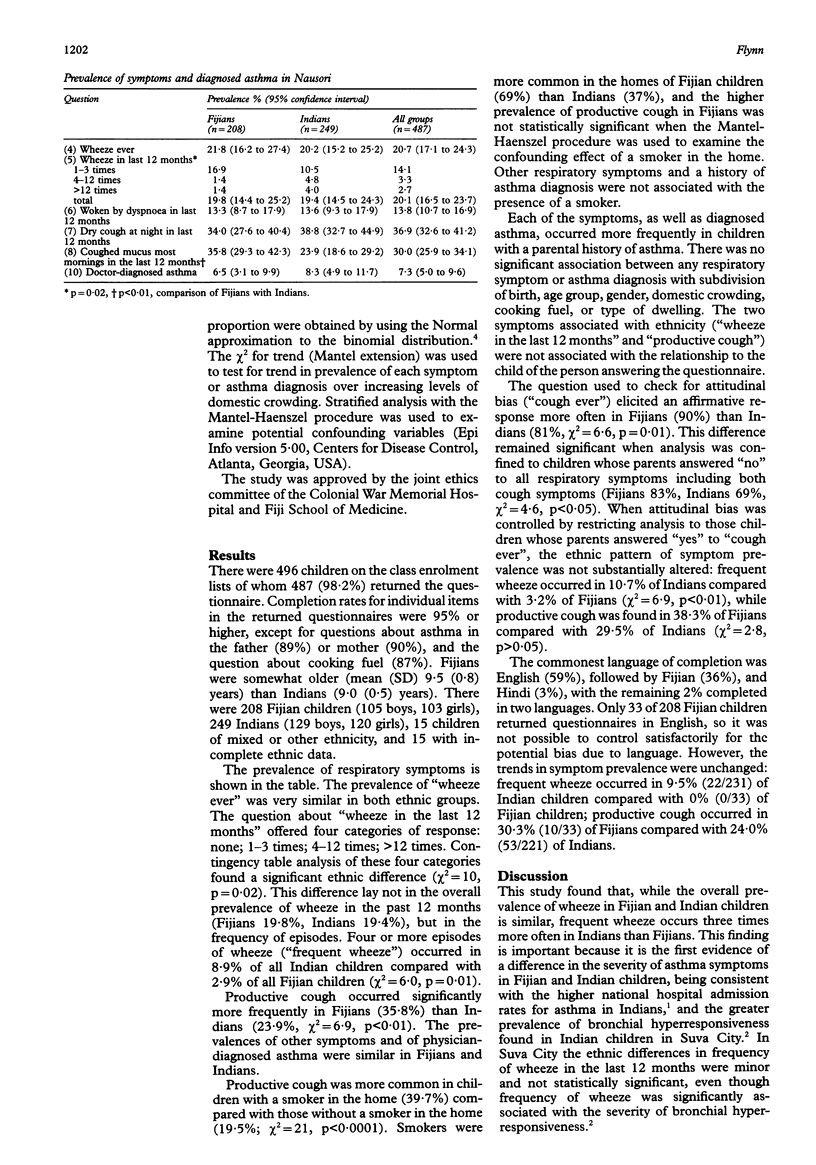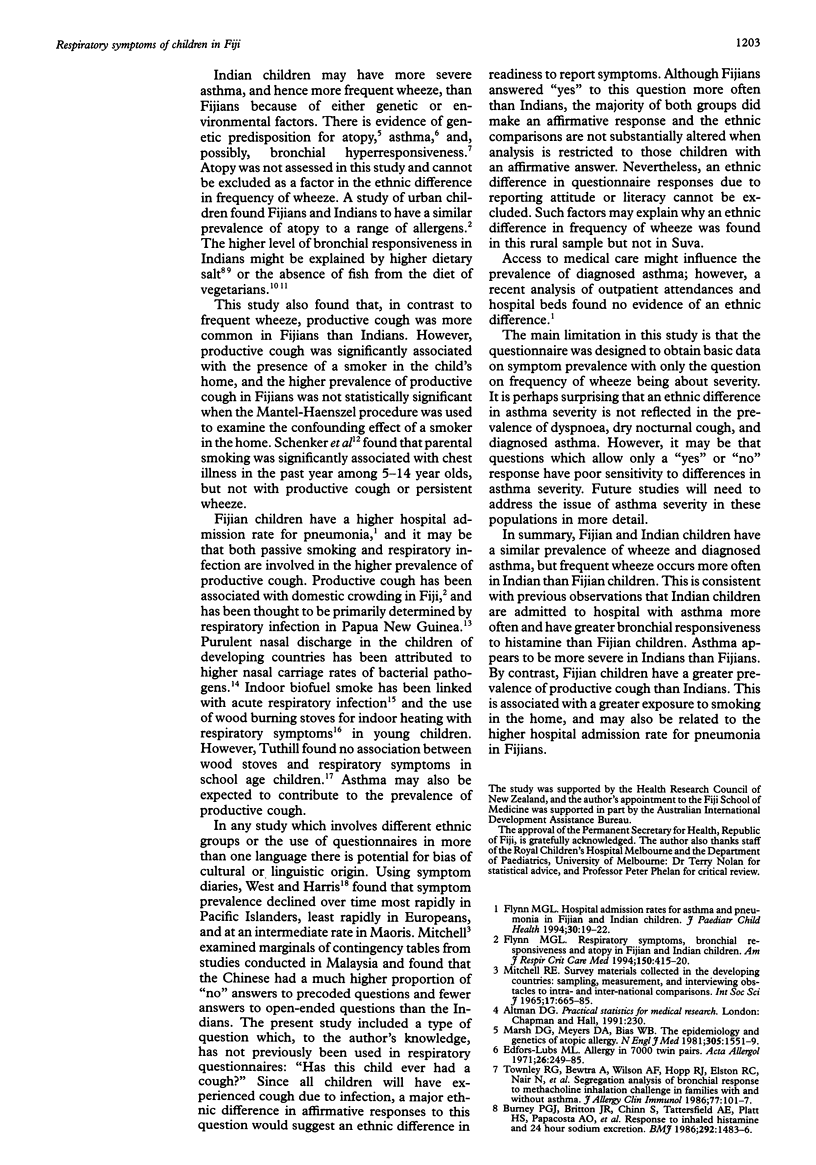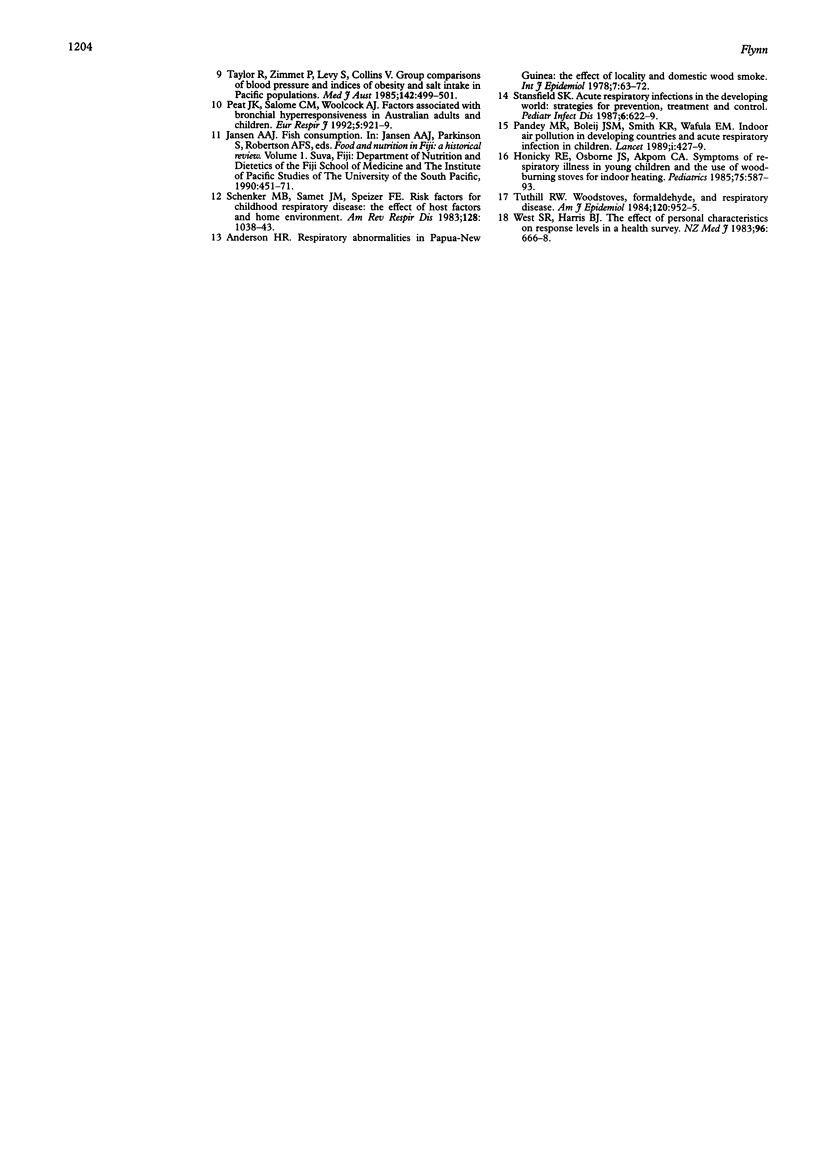Abstract
BACKGROUND--Significant ethnic differences exist in the respiratory morbidity of children in the Fiji Islands. Indian children have higher national hospital admission rates for asthma whereas Fijian children have higher admission rates for pneumonia. In Suva City the prevalence of wheeze is similar in Fijian and Indian children, productive cough is more common in Fijians, and bronchial hyperresponsiveness is more common in Indians. This study was undertaken to see whether ethnic differences in national hospital admission rates are reflected in the prevalence of respiratory symptoms in rural children. METHODS--A respiratory symptoms questionnaire in three languages with known repeatability was returned by 487 (98.2%) of 496 class 4 primary school children with a mean age of 9.3 years living in Nausori District, an agrarian region with a climate similar to Suva City. RESULTS--The prevalence of one or more episodes of wheezing in the last 12 months was similar in Fijians (19.8%) and Indians (19.4%). However, 8.9% of Indian children had experienced four or more episodes of wheeze in the last 12 months compared with only 2.9% of Fijian children. Productive cough on most mornings occurred more frequently in Fijians (35.8%) than Indians (23.9%), but this difference was not significant after controlling for the presence of a smoker in the home. CONCLUSIONS--This study provides the first evidence that frequent wheeze (four or more episodes in the last 12 months) is more prevalent in Indian than Fijian children. The higher prevalence of productive cough in Fijian children may be related to exposure to smoking in the home.
Full text
PDF



Selected References
These references are in PubMed. This may not be the complete list of references from this article.
- Anderson H. R. Respiratory abnormalities in Papua New Guinea children: the effects of locality and domestic wood smoke pollution. Int J Epidemiol. 1978 Mar;7(1):63–72. doi: 10.1093/ije/7.1.63. [DOI] [PubMed] [Google Scholar]
- Burney P. G., Britton J. R., Chinn S., Tattersfield A. E., Platt H. S., Papacosta A. O., Kelson M. C. Response to inhaled histamine and 24 hour sodium excretion. Br Med J (Clin Res Ed) 1986 Jun 7;292(6534):1483–1486. doi: 10.1136/bmj.292.6534.1483. [DOI] [PMC free article] [PubMed] [Google Scholar]
- Flynn M. G. Hospital admission rates for asthma and pneumonia in Fijian and Indian children. J Paediatr Child Health. 1994 Feb;30(1):19–22. doi: 10.1111/j.1440-1754.1994.tb00559.x. [DOI] [PubMed] [Google Scholar]
- Flynn M. G. Respiratory symptoms, bronchial responsiveness, and atopy in Fijian and Indian children. Am J Respir Crit Care Med. 1994 Aug;150(2):415–420. doi: 10.1164/ajrccm.150.2.8049824. [DOI] [PubMed] [Google Scholar]
- Honicky R. E., Osborne J. S., 3rd, Akpom C. A. Symptoms of respiratory illness in young children and the use of wood-burning stoves for indoor heating. Pediatrics. 1985 Mar;75(3):587–593. [PubMed] [Google Scholar]
- Marsh D. G., Meyers D. A., Bias W. B. The epidemiology and genetics of atopic allergy. N Engl J Med. 1981 Dec 24;305(26):1551–1559. doi: 10.1056/NEJM198112243052603. [DOI] [PubMed] [Google Scholar]
- Pandey M. R., Boleij J. S., Smith K. R., Wafula E. M. Indoor air pollution in developing countries and acute respiratory infection in children. Lancet. 1989 Feb 25;1(8635):427–429. doi: 10.1016/s0140-6736(89)90015-9. [DOI] [PubMed] [Google Scholar]
- Peat J. K., Salome C. M., Woolcock A. J. Factors associated with bronchial hyperresponsiveness in Australian adults and children. Eur Respir J. 1992 Sep;5(8):921–929. [PubMed] [Google Scholar]
- Schenker M. B., Samet J. M., Speizer F. E. Risk factors for childhood respiratory disease. The effect of host factors and home environmental exposures. Am Rev Respir Dis. 1983 Dec;128(6):1038–1043. doi: 10.1164/arrd.1983.128.6.1038. [DOI] [PubMed] [Google Scholar]
- Stansfield S. K. Acute respiratory infections in the developing world: strategies for prevention, treatment and control. Pediatr Infect Dis J. 1987 Jul;6(7):622–629. doi: 10.1097/00006454-198707000-00002. [DOI] [PubMed] [Google Scholar]
- Taylor R., Zimmet P., Levy S., Collins V. Group comparisons of blood pressure and indices of obesity and salt intake in Pacific populations. Med J Aust. 1985 Apr 29;142(9):499–501. doi: 10.5694/j.1326-5377.1985.tb133191.x. [DOI] [PubMed] [Google Scholar]
- Townley R. G., Bewtra A., Wilson A. F., Hopp R. J., Elston R. C., Nair N., Watt G. D. Segregation analysis of bronchial response to methacholine inhalation challenge in families with and without asthma. J Allergy Clin Immunol. 1986 Jan;77(1 Pt 1):101–107. doi: 10.1016/0091-6749(86)90330-1. [DOI] [PubMed] [Google Scholar]
- Townley R. G., Bewtra A., Wilson A. F., Hopp R. J., Elston R. C., Nair N., Watt G. D. Segregation analysis of bronchial response to methacholine inhalation challenge in families with and without asthma. J Allergy Clin Immunol. 1986 Jan;77(1 Pt 1):101–107. doi: 10.1016/0091-6749(86)90330-1. [DOI] [PubMed] [Google Scholar]
- Tuthill R. W. Woodstoves, formaldehyde, and respiratory disease. Am J Epidemiol. 1984 Dec;120(6):952–955. doi: 10.1093/oxfordjournals.aje.a113966. [DOI] [PubMed] [Google Scholar]
- West S. R., Harris B. J. The effect of personal characteristics on response levels in a health survey. N Z Med J. 1983 Aug 24;96(738):666–668. [PubMed] [Google Scholar]


